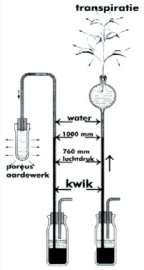Clearly visible here, is the narrow contact between hair-vessels and soil-particles. Absorbing water does not come from active transport, but could well be compared to the cotton of an oil-lamp continuously sucking up oil towards the place of combustion (towards the flame).
The intake of water by the roots is controlled through it’s suction. This has to be lower than that of the soil (otherwise water would flow from the roots into the soil). With extremely dry soil this may actually happen!). this water-suction is dependant on the amount of resistance water encounters in penetrating the root. The resistance is among other factors, influenced by the soil-temperature. This on account of the fact that water’s viscosity (it’s toughness) rises when the temperature drops (the water becomes thick). If the bottom is warm, this means low water resistance, but if it is cold, resistance becomes high.
The second, and largest driving force behind water absorption is perspiration (the evaporation of water from the leaves). When much is evaporated, the suction in the roots grows larger (like with a fungus). Evaporating water from the leaves is in tune with the air-humidity (low R.H. = much evaporation, and vice versa) inside the room.
The following drawing depicts an experiment which proves that perspiration of the leaves causes suction (negative water-pressure) even greater than the force of regular air-pressure.
Water transport inside the roots
The hair-vessels are of a delicate structure, and are surrounded by thin shells, through which water and unsolved nutrients may easily pass. The resistance to water here is minimal. The outer surface is increased enormously by branching out. In the middle of the root we find the central cylinder: the highway up. Water flows here from the hair-vessels. This section has the largest resistance to water, for many membranes have to be passed through here. In the hair-root region, the plant has an enormous force outer surface, which has intensive contract with it’s environment.
Demonstration of the suction which can only be achieved through leaf-perspiration. The plant may pull the mercury up higher as would air-pressure inside a barometer. This experiment proves that perspiration is the driving engine behind water absorption into the roots.
Plants can experience water stress
If ground temperature and air-humidity are both low, much water leaves the leaves through perspiration, but the roots can’t keep up, due to high water resistance. Symptoms: weak or dead leaves on wet soil, and decaying roots, of fungi will soon follow.
Before we continue with more facts, let’s put this in practice. The plant-medium can’t be constantly dry or wet. Plants cannot actively absorb water, and never more than the amount which is perspired by the leaves. Don’t water ‘for storage’. This activity should be taken care of by your soil (perhaps by adding perlite). This achieves a water-buffer capacity. Hydro-systems should drop little but often, this imitating the water-buffer (not too wet and not too dry). The plant-medium should posses sufficient solidity in order to anchor the supportive roots, but it should also be soft enough to let the root-tubes through.
Send a message to SpeesCees:
Copyright © No Mercy Seeds










